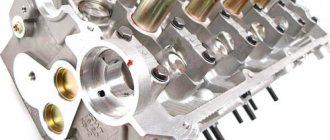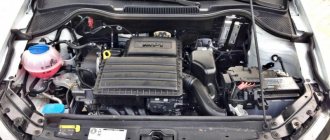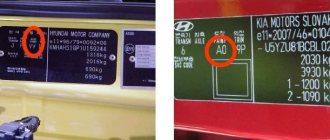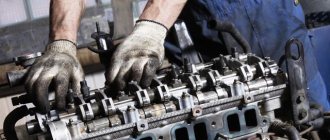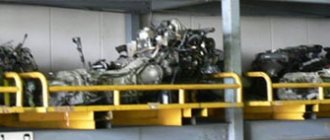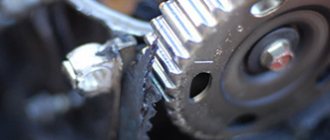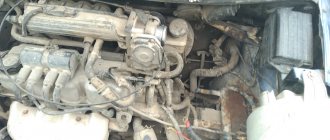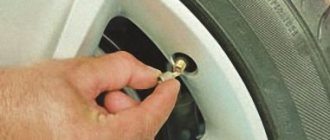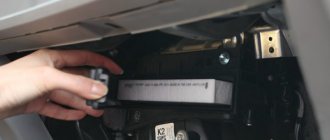Many car enthusiasts are interested in the question of what is the service life of the Hyundai Solaris engine, because it determines the service life of one of the most popular budget cars in Russia, the engine range of which is represented by two gasoline units, 1.6 and 1.4 liters.
Both of these engines belong to the new Gamma series, which replaced the Alpha series, the main distinguishing features of which are:
- timing belt,
- front location of the catalyst,
- hydraulic valve compensators.
The engines of the old series are designated G4EE, the new series are designated G4AE.
G here is the abbreviation for “gazoline” (gasoline), 4 is the number of cylinders available, and the last 2 letters indicate the engine model.
But the difference between motors of different series lies not only in one letter of the name, they are much more significant. Thus, Gamma engines are characterized by:
- timing chain drive (remember, in the previous series it was a belt drive) with hydraulic tensioners located on both sides - it does not require maintenance and eliminates the risk of phase displacement when the chain is stretched;
- reverse location of the catalyst - it, together with the exhaust manifold, is located behind the power unit, between it and the engine shield, which leaves more space for shock absorption, while the intake manifold is located in front of the engine, thereby guaranteeing a lower air inlet temperature (the colder the incoming air , the denser it is and the more (by mass) it gets into the cylinder, which means more fuel can be supplied to it, thereby increasing the power of the car);
- the absence of hydraulic compensators in the valve drive device - eliminated the problem of valve knocking when starting the engine;
- the cylinder axis is shifted by 1 cm relative to the crankshaft axis, significantly reducing the load on the piston skirt;
- lighter, but at the same time reinforced, cylinder block;
- changed arrangement of mounted units - the generator in the Gamma series is located slightly higher than before, which reduces the risk of flooding it with water when driving through puddles; the air conditioning compressor is in front of the engine, and the power steering pump is at the rear;
- the presence of a variable valve timing system on the intake shaft, which allows you to increase power at medium and low speeds.
Technical characteristics of Hyundai Solaris engines and their service life.
| Characteristic | Engine volume 1394 cm3 | Engine capacity 1591 cm3 |
| Power | 107-109 l. With. | 122 l. With. |
| Number of valves | 16 | 16 |
| Maximum torque | 135Nm/5000 rpm min | 155 Hxm/4200 rev. min |
| Fuel | AI-92 | AI-95 |
| Piston stroke length | 75 mm | 85.4 mm |
| Number of cylinders and their size | 4 (77 mm) | 4 (77 mm) |
| Compression ratio | 10,5 | 10,5 |
| Eco-friendly class | Euro 4 | Euro 4 |
As you can see, there are not so many differences, so it is not surprising that the engine life of the Hyundai Solaris 1.6 declared in the technical data sheet and the engine life of the Hyundai Solaris 1.4 are identical and amount to about 180 thousand kilometers. By the way, in fact, with proper and careful use, they can reveal much greater potential. This doesn't require much.
Increased service life of 1.4, 1.6 engine
Power units 1.4 and 1.6 not only have good technical characteristics, but also have a high level of reliability. During the operation of the sedan, the owners do not have any major complaints about the operation of the engine. The service life of the engine directly depends on the operating conditions of the car and timely maintenance. Therefore, the figure of 180 thousand km can in practice vary up and down. It all depends on the car owner himself. You can increase the engine life of Hyundai Solaris in the following ways:
- Refuel your car only at proven and certified gas stations. This way the driver can be sure that the car is “powered” by normal fuel;
- The use of certified oil, which is recommended by the car manufacturer itself, also has a significant impact on the duration of trouble-free operation of the sedan;
- You should not force the power unit to wear out. Operating the engine at its limit only contributes to an increase in the level of wear of parts, which in turn provokes premature breakdowns.
Thus, the service life of the Hyundai Solaris power unit depends only on the owner. Timely maintenance of the car and proper care increases its service life significantly. Engines with a displacement of 1.4 and 1.6 liters are distinguished by their reliability and unique design, which increases the reliability of key engine parts. In practice, it has been verified that both of these engines are capable of covering more than 300 thousand kilometers before the first serious breakdown occurs.
Tips on how to increase engine life.
- – in this case, use only high-quality lubricants recommended by the manufacturer, and with it oil and.
- Refuel only with good fuel; its quality can only be guaranteed by proven gas stations.
- Do not drive at high speeds - operating the engine in conditions close to the limit will not result in anything good for either the engine or other parts of the car, as well as long-term idling, so it is better to prefer gentle movement to warming up in winter.
And most importantly, take care of the “heart” of your car - change spark plugs in a timely manner, flush the injection system, etc. - and then it will definitely respond to you with long, uninterrupted operation.
Manual and automatic transmissions Hyundai Solaris
For Hyundai Solaris, classic mechanics and automatic are available. The car was equipped with two different automatic transmissions: four- and six-speed. Moreover, the six-speed gearbox labeled A6GF1 is more economical, pleases with smooth operation, but disappoints with a mediocre response to pressing the gas pedal. The A6GF1 holds 7.3 to 7.8 liters of ATF.
Although the plant does not provide for changing the oil in the automatic transmission, this should be done every 80–100 thousand km. After all, the A6GF1 gearbox is sensitive to the quality and pressure of the oil, the integrity of the seals and gaskets. If you neglect maintenance, critical wear and failure of solenoids and clutches are likely. The additive will help restore the automatic gearbox and prevent its wear.
Five- and six-speed manual transmissions of the Hyundai Solaris are quite reliable, which is confirmed by the experience of their operation on the Elantra and other Korean models. Among the factory shortcomings of the five-speed unit are increased noise and a hum when reversing. The defect appeared on cars manufactured before 2012.
In manual transmissions, we recommend changing the oil every 50–60 thousand km. And to extend the life of the box, use. Thanks to the additive, it will be possible to extend the life of parts, compensate for wear on friction surfaces, achieve easier shifting, reduce transmission noise and restore gears.
Many car enthusiasts are interested in the service life of the Hyundai Solaris 1.6 engine. After all, the service life of the car directly depends on this indicator. There are 2 types of this indicator. One is called the engine's factory life. This value refers to the estimated service life of the engine. Another indicator is the actual resource, and it depends directly on the characteristics of operation. In practice, one owner can drive 200-300 thousand kilometers without problems, while another will destroy the engine for 50 thousand.
Therefore, the factory resource can only be viewed as reference material. You can find out the service life of a specific power unit from the technical specifications published by the manufacturer.
How many seconds does it take to accelerate to 100 km/h?
27 Feb 2011 23:25 | AlexUnit in Engine and fuel system How many seconds does it take to accelerate to 100 km/h? According to official figures, acceleration 0-100 km/h: 1.4 l. 5MT - 11.5 sec. 1.4 l. 4AT - 13.2 sec. 1.6 l. 5MT - 10.2 sec. 1.6 l. 5AT - 11.2 sec. Read more →
Are there problems?
Car owners are faced with the fact that they often have to talk about major engine repairs. This is not at all pleasing, and the whole point is due to engineering flaws, although they are making a lot of efforts to correct the situation. Repairs cost considerable sums. After all, the price of a Hyundai-Solaris engine is approximately 50 thousand rubles.
The main culprit for this state of affairs is the rapid wear of aluminum pistons and cylinder walls. In this regard, on new devices, designers use methods of pressing cast iron sleeves, chemical methods of treating aluminum surfaces with nickel or silicon carbide.
The problem with carrying out repair work is as follows. The automaker did not provide for repairs and does not produce the corresponding auto parts, rings, pistons. The sleeve is hidden in an aluminum block so much that boring it is simply impossible.
Theoretically, replacing liners is possible, but not every car service undertakes to carry it out. The only solution is a unit replacement of the Hyundai-Solaris engine, which is recommended to be entrusted to professionals. As a result, major repairs cannot be avoided by all owners of this brand.
Such a nuance is not a reason to refuse the vehicle you like. You just need to follow some rules during operation.
- Installing Hyundai-Solaris engine protection in the form of crankcase protection will help increase the life of the power device. Shields that protect the engine from stones and moisture are purchased for a specific car.
- It is more profitable to refuel at a gas station with an established positive reputation as an honest dealer of petroleum products. Fuel must be certified. The quality of fuel determines by 50% how long a car engine will live.
- Lubricating fluids must also have quality certificates. Experts advise using oil recommended by the car manufacturer itself. In this case, there is a chance to avoid imminent difficulties on the roads.
- Overloading a vehicle has a detrimental effect on the resource. Constant heavy loads and the driver's desire for a sporty driving style lead the unit to a deplorable state. Worn-out components of the unit provoke premature contact with a car repair shop.
To summarize the above, it is worth noting that the right solution to eliminating problems is prevention. Every driver can do this. Timely maintenance and frequent diagnostics, even when everything is fine, will not be superfluous. Usually, if the manufacturer's regulations are followed and frequent inspections by professionals, the service life increases significantly, reaching 300 thousand kilometers.
The Hyundai Solaris car has gained great popularity around the world. And this is not strange, because the car is inexpensive, but at the same time it looks great and performs its functions. Of course, there are certain problems, but you can’t live without them.
The disadvantages of the car are often the engine performance. In general, today there is a popular opinion that all cars are made in such a way that they will have to be replaced within 5-10 years, and the familiar Hyundai Solaris with its “aluminum” engine is cited as an example.
Owners of domestic Zhiguli cars have heard the word “Kapitalka” hundreds of times. The point of this process is to protect one of the most expensive parts of the car - the cylinder block - from wear.
Since the time when Zhiguli cars appeared, major repairs have meant the restoration of old cylinders by boring them to the required size.
This also meant replacing cartridges. Next, the craftsmen installed pistons of the required size, and these parts were made by the manufacturer of the car itself. Motors could have up to 5 different repair sizes, so the engine could be “rejuvenated” several times.
In such cars, cast iron was used to produce the cylinder block; it is a heavy substance, but it is very strong and can be easily bored. Repairs became more difficult when companies began to produce cylinder blocks made of aluminum; this made it possible to reduce the weight of the car, but made it more difficult for the Kapitalka.
When is the engine on Solaris beyond repair?
Diagnosing the dying state of an engine is quite simple. This will be indicated by both the mileage on the odometer and completely objective symptoms :
- Uniform drop in compression in all cylinders.
We check the compression in the cylinders.
- Significant drop in power and deterioration in dynamics.
- Increased oil consumption, characteristic smoky exhaust.
- Low pressure in the lubrication system.
- Noise in the area of the cylinder-piston and crank groups.
- Displacement of the crankshaft along the longitudinal axis.
Same type “disposable” engines
To some extent, the Gamma engine is still disposable, but it is not the only one. The engine of the first Skoda Fabia a 1.2–1.4-liter naturally aspirated BRZ Volkswagen EA211 TSI engine is made using the same technology and the manufacturers can be understood - they are not very interested in reliability and half-million miles, they need to sell maximum equipment at minimum costs.
BRZ naturally aspirated engine.
Engine EA211 TSI.
Does Hyundai assemble the automatic transmission itself?
27 Feb
2011 23:28 | AlexUnit in Engine and fuel system Does Hyundai assemble the automatic transmission itself? Hyundai actually assembles automatic transmissions; the 4-speed automatic transmission is supplied and assembled entirely from the Czech Republic. Read more → Next page »
